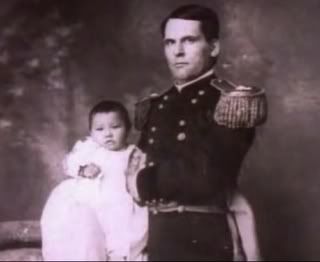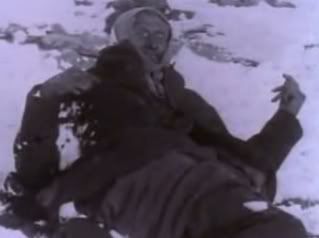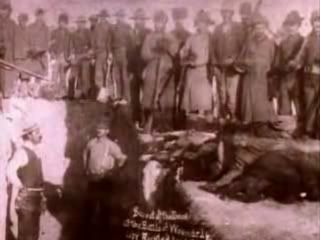
On January 1st 1891, three days after the massacre, so many mangled bodies lay beneath mounds of freezing snow (some yet alive), meanwhile the residents of the Valley of White Creeks are going about their daily lives as normal, sweeping the snow from their porches and clearing the sidewalks. The 7th Cavalry, 700 hundred strong, walks about the snow in their thick coats and warm muskrat hats. They prepare breakfast, have some coffee, and tend to their horses as they get ready for the short trip back up the ridge (slightly east of Pine Ridge) to Wounded Knee once more.
After breakfast, some of the men mounted up their horses while others hopped in the wagons. Dr. Charles A Eastman (full-blood Santee Sioux) along with 75 Ogalala Indians went along as did 30 men who were hired to bury the dead for $2.00 a body. The doctor and his companions were anxious, in hopes of finding some of their family still alive.
Upon arriving at the haunting scene of devastation, they all stood and stared in silence as they looked upon the terrible sight. The land was dotted with numerous mounds of snow, hiding the dead beneath. All along the crescent, where over 100 tepees (tipis) once stood, housing Chief BigFoot and his people, now were they flattened, torn into ribbons, and strewn across the landscape.
In the deep ravine where many old people, woman, and children had run for protection after the shooting began , now lay thick mounds of snow, heaped with many bodies on the bottom of the ditch and many scattered on the sides where they fell after being mowed down.
The Indians began to cry out with the most shrill and painful loud cries as the women moaned in deep pain at the sight. The army became restless, fearing that the Indians may lose it, so the doctor doing his best to keep it together told his people to go look in the mounds to see if their be anyone alive. Later the doctor said, “It took all of my nerve to keep my composure in the face of this spectacle, and of the excitement and grief of my companions.”
In each mound were found human forms torn by shrapnel, carbine bullets, blood caked all over their frozen contorted bodies that was a witness to a horrible death. Paddy Starr found three pregnant women who were riddled with artillery, another with her stomach blown out, and a 10 year old child lying there with his arm, shoulder, and chest torn away. Others were found in like-conditions.

The thickest mounds of bodies lie in the Council Square and this is where Chief Big Foot’s body was uncovered from the snow. He was in a near sitting position as if looking over the devastation of his people. His body now lay frozen, still bundled in the thick clothing and head scarf he had dressed in because of being very sick with pneumonia; Chief Big Foot was struck down in the first line of fire. Yellow Bird’s swollen and charred body lie on the ground near by.
Doctor Eastman found a blind and helpless little old lady, still alive, beneath a wagon. At Louis Mosseaus Trading Post a short distance, several of the injured made it there and escaped the blizzard; some yet alive, some had died. Under a mound of snow, Doctor Eastman found a little baby girl about 4 months old wrapped in a thick shawl nestled against her dead mother; she had been shot with two bullets. On her head, the baby was wearing a cap made of buckskin, with a U.S. flag embroidered in beads on it; surely her mother lovingly made it for her.
All together, 5 adults and two children were found alive. They were loaded up in the wagons and dropped off at a chapel, with the injured that were brought there several days before. Reverend Charles Cook (one of the Native Americans own people) turned the chapel into a makeshift hospital; he had all the pews torn out and carpeted the floors with straw and quilts trying to make it as comfortable for them as he could. One badly injured old man was greeted by his tearful wife and children, only to die a few days later.
The baby found wrapped up and snuggled against her dead mother was adopted by Brigg L.W. Colby. Some of the Indians called her Zintka Lanuni, “Lost Bird” and others called her Ikicize Wanji Cinca, “Child of the Battlefield.” A teacher by the name of Lucy Arnold adopted Yellow Bird’s son, and Capt George Sword (Head of the Pine Ridge Police) adopted a little 5 year old girl.
The burial team stayed on until the next day. A large rectangular deep pit was dug to on the hill where the artillery had been set up several days earlier, from where the army blasted away at “anything that moved”. (As told by a gleeful soldier.) The deep hole was dug for a mass burial, for convenience I am sure, without a ceremony. Some of the white men hurried to strip many of the corpses of their clothes for souvenirs, especially desirous of the “Ghost Shirts” they wore before beginning the burial. After the stripping was done, they proceeded to throw the pitiful mangled bodies into this massive grave; after they pushed the last body in, they all stood around posing for a picture. They threw dirt in over their bodies, loaded up, and left.

One observer said, “It was enough to melt the heart of a man if it were stone, to see these little children with their bodies shot to pieces, thrown naked into the pit.”
Dr Eastman wrote this, after the victims of the slaughter were first brought into the chapel on December 29 1890:
“There we laid the poor creatures, in rows and the night was devoted to caring for them the best we could. Many were frightfully torn by pieces of shell, and the suffering was terrible. General Brooke placed me in charge, and I did nearly all the work, for although the army surgeons were more than ready to help, as soon as their own men were cared for, the tortured Indians would hardly allow a man in uniform to touch them. Mrs Goodale, Mrs. Cook, and several of Mr. Cook’s Indian helpers acted as volunteers. In spite of all our efforts, we lost the greater part of them, but a few recovered, including several children who had lost all their relatives and who were adopted into kind Christian families.”


Dewey Beard, a Native American who survived the horrible ordeal; For a few moments Dewey watched the women and children surging up the ravine. Many fell as shrapnel and bullets hit them. Hugging the banks, mothers clawed at the sides of the ravine, digging shelter in which to place their infants. Crawling up the ravine, Dewey overtook his mother, badly wounded, holding a soldiers gun in her hand. “My son,” she said, pass by me, I am going to fall down now.” Another bullet hit her, and she slumped to the ground, dead. Dewey continued his painful journey up the ravine looking for his wife, she (Wears Eagle) was in fact dead but he didn’t know this yet. Infact when they found her later, she was shot in the chest and her 25-days- old baby (Wet Feet) was nursing at her mother’s breast. Because of suckling so much blood in, it is believed this is why she died several months later. Dewey had lost his wife, his mother, his father, and his two brothers.
Phillip Wells walking along the ravine cried out in Sioux that if there was anyone alive to come out and they would not be hurt. An old man painfully raised up out and Paddy Starr watched in horror as the 1st of Rice’s platoon relentlessly swept the ravine from above with their deadly carbines. (The author says they must not have heard Phillip tell them it was safe to come out … I don’t believe this but believe what the one soldier bragged to others, that they fired hitting anything that moved.)
Exactly how many Native Americans died in this holocaust is not known: Total of 146? 84 men, 44 women, 18 children. They say of the 51 wounded only 7 died? I find that odd, after Doctor wrote that of all the wounded, they lost almost all of them the first night. I believe the doctor.
I got the information for this post from the book:
"The Last Days of the Sioux Nation" written 1963 by Robert M. Utley
For more information: http://www.nativeamericanindianbloodlines.com/

No comments:
Post a Comment